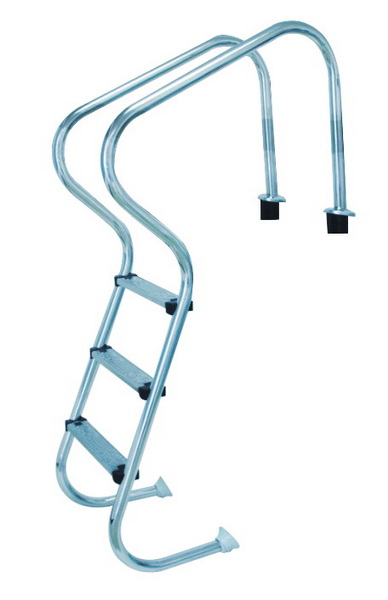Views: 222 Author: Tina Publish Time: 2025-10-03 Origin: Site








Content Menu
● What Causes Rust on Pool Ladders?
● How Rust Impacts Your Swimming Pool
● Preventing Rust on Pool Ladders
● How to Fix Rust on Pool Ladders
● Pool Ladder Alternatives to Avoid Rust
● Maintenance Schedule for Pool Ladders
● Extra Tips for Rust Prevention
>> 1. Can I still use a rusty pool ladder?
>> 2. What ladder type is best for saltwater pools?
>> 3. How do I remove rust stains from tiles below the ladder?
>> 4. How often should I inspect my pool ladder?
>> 5. Do resin ladders eliminate rust issues?
Owning a swimming pool is an enjoyable luxury that comes with an important responsibility: proper care and maintenance. One of the common issues pool owners encounter is finding rust forming on their pool ladder. This often leads to the question: “Why is my pool ladder rusting?” Stainless steel ladders are designed to resist corrosion, but under certain conditions, even high-grade metal can succumb to rust. Understanding why this happens, how to prevent it, and how to deal with existing rust is crucial for both safety and aesthetics.

Pool ladders are constantly exposed to water, chlorine, chemicals, and outdoor elements. While stainless steel is strong and resistant, it is not indestructible. Let's explore the main reasons:
- Chemical Imbalance in the Pool Water
Incorrect chlorine, pH, or alkalinity levels make water corrosive. Low pH increases acidity, while excess chlorine or salt creates harsh conditions that damage metal.
- Lower-Grade Stainless Steel
Stainless steel varies by grade, with 316 marine-grade being the best for pools. Cheaper ladders made with 201 or 304 stainless steel corrode more quickly.
- Saltwater Pools
Salt chlorination systems, while convenient, are tougher on metals. Salt accelerates oxidation if the ladder is not properly designed for such conditions.
- Surface Damage
Even minor scratches weaken the protective chromium oxide layer, allowing rust to penetrate exposed steel.
- Inadequate Cleaning
Everyday debris, oils, and chlorine deposits settle on ladders. Without routine cleaning, corrosion layers start forming.
Rust is not only an unattractive blemish on stainless steel. It has multiple consequences:
- Safety Risks – Corroded ladders may weaken, posing risks of collapse or injury. Rust can also leave sharp edges.
- Water Appearance – Rust particles spread and cause discoloration in the pool water.
- Staining Surfaces – Rust stains can appear on tiles, liner walls, and decking.
- Reduced Equipment Life – Corrosion shortens the overall lifespan of ladders and other pool accessories.
Prevention is easier and less costly than replacement. Pool owners should adopt the following best practices:
1. Maintain Balanced Water Chemistry
- pH range: 7.2–7.6
- Chlorine: 1–3 ppm
- Alkalinity: 80–120 ppm
- Calcium hardness: 200–400 ppm
2. Invest in Marine-Grade Stainless Steel
Purchase ladders specifically labeled *316 marine-grade*. This grade is far superior when it comes to resisting salt and chlorine.
3. Rinse and Clean Often
Hose down the ladder with fresh water after each use. Remove oils or sunscreen residues with mild, non-abrasive cleaning products.
4. Apply Protective Coatings
Wipe stainless steel sealant or a thin transparent coating on the ladder's surface to create a barrier.
5. Seasonal Removal
If your pool is not open year-round, store ladders indoors when not in use. Dry storage dramatically reduces risk of corrosion.

If rust has already appeared, action must be taken immediately. Here are practical solutions:
- Light Surface Rust Treatment
Rub gently with a non-abrasive pad and apply stainless-steel polish.
- Homemade Remedies
A paste made of lemon juice and baking soda can be applied to rust spots and scrubbed away after 10–15 minutes.
- Rust Remover Products
Oxalic acid cleaners work well but require gloves and eye protection during handling.
- Electro-polishing
A professional treatment where the ladder's surface is electrically polished, restoring corrosion resistance.
- Replacement
When corrosion becomes structural, ladder replacement is the only safe option.
If rust remains a problem even with regular maintenance, consider different ladder materials:
- Resin/Plastic Ladders – Rust-proof, lightweight, and affordable.
- Composite Ladders – Combination of resin with metal components for durability.
- Titanium-Coated Stainless Steel – Premium choice for saltwater resilience, though more expensive.
| Task | Recommended Frequency |
|---|---|
| Test and balance pool water | 2–3 times a week |
| Inspect ladder for rust | Weekly |
| Rinse ladder with fresh water | After each swim |
| Deep clean with stainless cleaner | Monthly |
| Remove and store ladder seasonally | End of pool season |
- Never use abrasive steel wool – It damages surfaces and accelerates corrosion.
- Avoid mixing pool chemicals near ladders – Splashes of concentrated chlorine cause immediate pitting.
- Add sacrificial zinc anodes – These protect metal components by corroding in place of your ladder.
- Regular inspections – Early intervention prevents deeper corrosion that is impossible to reverse.
- Consult the manufacturer – Follow care guidelines specific to your ladder's material.
Rust on pool ladders usually results from improper pool water balance, low-grade stainless steel, scratches, or poor maintenance. While stainless steel is designed to resist rust, even strong materials degrade under challenging pool conditions, especially in saltwater setups. Preventing corrosion requires commitment: test water frequently, clean and rinse ladders after use, and apply protective coatings. For saltwater pool owners, 316 marine-grade stainless steel or titanium-coated ladders are crucial investments. If rust appears, act quickly with polishing or professional care before structural weakening occurs. Ultimately, vigilance in pool maintenance keeps your ladder safe, stunning, and long-lasting, ensuring your pool remains a place of joy rather than frustration.

Small rust spots don't affect integrity immediately, but if corrosion spreads, replacement is necessary to prevent accidents.
A 316 marine-grade stainless steel or titanium-coated ladder is ideal for saltwater environments.
Use pool-safe stain removers or diluted ascorbic acid solutions to gently lift stains.
Check weekly for rust or damage. Routine visual inspections catch corrosion early.
Yes, resin or plastic ladders don't rust. However, they may have lower weight-bearing capacity compared to stainless steel models.
